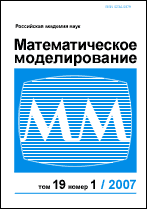|
This article is cited in 16 scientific papers (total in 16 papers)
The use of full-wave numerical simulation for the investigation of fractured zones
A. V. Favorskayaabc, I. B. Petrovba
a Scientific Research Institute for System Studies of the Russian Academy of Sciences
b Moscow Institute of Physics and Technology
c Non-state Educational Institution "Educational Scientific and Experimental Center of Moscow Institute of Physics and Technology"
Abstract:
In this paper we describe the stages and results of the investigation of the features of oilsaturated fracturing zones by applying the analysis of spatial dynamical wave patterns, obtained as a result of supercomputer modeling by the grid-characteristic method. Fullwave modeling is used in geophysics to construct synthetic seismograms and as part of solving inverse problems. In this paper we demonstrate that it is possible to derive conclusions that can later be useful in carrying out geophysical studies by analyzing the calculated spatial dynamic wave patterns. The proposed approach of wave patterns analyzing simplifies the study of the dynamics of different wave types in comparison with the methods of analyzing and interpreting the seismograms, and is more accurate than the ray-tracing method and the geometric approximation. Three types of fractured clusters are considered: "Solid", "Intermittent" and "Chess". As a result of the research, characteristic regularities were obtained, for example, the dependence of the angle of scattering seismic waves on the frequency used and on the geometrical features of location of the fractures into the clusters and the dependence on the source frequency of the trajectory and the velocity of motion of the point of separation of the longitudinal head wave from the S-wave. These regularities can subsequently be adapted to optimize the process of seismic prospecting of hydrocarbons and fractured zones investigation, for example, for the selection of the optimal equipment and the method of seismic survey. Also, we discuss the importance of studying of the spatial dynamic wave patterns when developing and testing of numerical methods, interface and boundary conditions, including the absorbing ones. Also, we propose the approach to construct a nonlinear scale that allows simultaneous analysis of spatial dynamic wave processes whose amplitudes differ by more than 20 times.
Keywords:
wave dynamics, elastic waves, fractured zones, supercomputer modeling, grid-characteristic method, seismic survey.
Received: 12.02.2018
Citation:
A. V. Favorskaya, I. B. Petrov, “The use of full-wave numerical simulation for the investigation of fractured zones”, Matem. Mod., 30:11 (2018), 105–126; Math. Models Comput. Simul., 11:4 (2019), 518–530
Linking options:
https://www.mathnet.ru/eng/mm4021 https://www.mathnet.ru/eng/mm/v30/i11/p105
|

| Statistics & downloads: |
| Abstract page: | 267 | | Full-text PDF : | 63 | | References: | 39 | | First page: | 2 |
|




 Contact us:
Contact us: Terms of Use
Terms of Use
 Registration to the website
Registration to the website Logotypes
Logotypes








 Citation in format
Citation in format 
